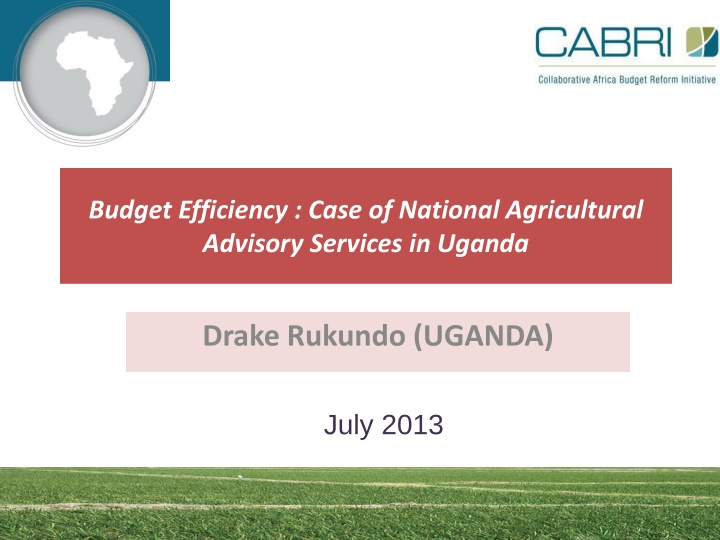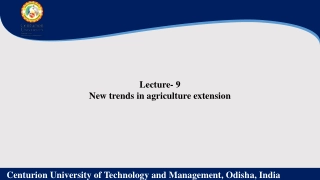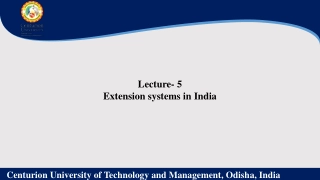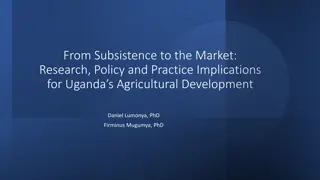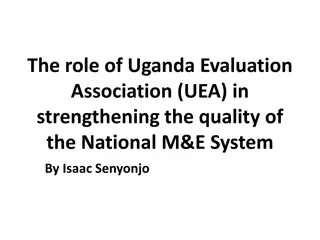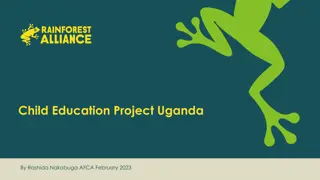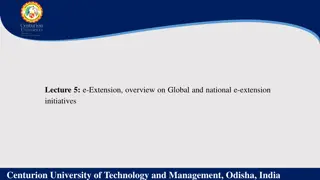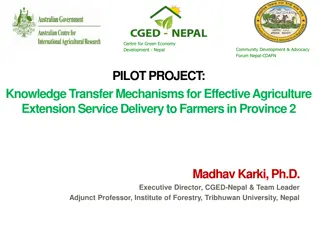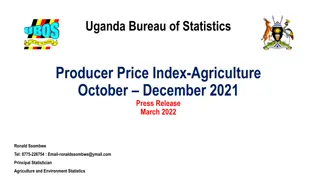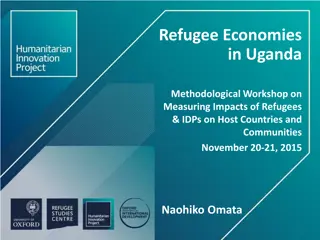Enhancing Agricultural Extension Services in Uganda: A Case Study of NAADS
The National Agricultural Advisory Services (NAADS) in Uganda is a decentralized and farmer-owned extension system aimed at improving food security and increasing farmers' incomes. This program focuses on providing farmer-centered advisory services to empower subsistence farmers and shift towards private delivery of agricultural services. Through structured implementation strategies and core objectives, NAADS aims to enhance the agricultural sector's development in Uganda.
Download Presentation

Please find below an Image/Link to download the presentation.
The content on the website is provided AS IS for your information and personal use only. It may not be sold, licensed, or shared on other websites without obtaining consent from the author.If you encounter any issues during the download, it is possible that the publisher has removed the file from their server.
You are allowed to download the files provided on this website for personal or commercial use, subject to the condition that they are used lawfully. All files are the property of their respective owners.
The content on the website is provided AS IS for your information and personal use only. It may not be sold, licensed, or shared on other websites without obtaining consent from the author.
E N D
Presentation Transcript
Budget Efficiency : Case of National Agricultural Advisory Services in Uganda Drake Rukundo (UGANDA) July 2013
Key Aspects of the Presentation 1. A Synopsis of the NAADS Program in Uganda 2. Explanation of the Dialogue Questions 3. Content, Structure and Presentation of Evidences in the Case Study 4. Suggestions for Group Work in discussions around the key Case questions
About NAADS A decentralized, farmer owned and private sector serviced extension system contributing to the realization of the agricultural sector development objectives of increasing food security and lifting incomes of Ugandan farmers through the provision of farmer-centered advisory services NAADS is an alternative to the Training and Visit (T&V) system. With NAADS, Uganda became one of the first African Countries to implement this common framework for agricultural extension.
About NAADS 1. Uganda is implementing a Decentralization form of Governance under which structures NAADS is implemented The idea of NAADS was part of an attempt to expedite support service extension, however it later became imperative to supply inputs alongside advisory services The private sector services providers and a new management structure were established as vehicles of implementation 2. 3.
NAADS Core Objectives 1. Creation of options for financing and delivery of appropriate advisory and technical services for different farmer types; 2. Gradually reducing the share of public financing of farm advisory costs such that public financing of farm advisory does not exceed 50%; 3. After the first phase of the NAADS, to realize a shift from public to private delivery of advisory services; 4. To empower subsistence farmers with access private extension services and market information; and 5. To develop the professional capacity of the private sector to sustainably meet the demand for agricultural services at the grassroots.
How implementation was carried out An Implementation Strategy with Guidelines that involved five (5) aspects 1. NAADS Secretariat at National Level 2. District NAADS Coordinators at District Level 3. Sub County NAADS Coordinators at Sub-district levels 4. Each farmers within a village constituted a Farmer Forum aided by Group Promoters trained under Farmer Institutional Development Support Project (Farmer Forums supported with Demonstration sites, linked to markets and encouraged to organize themselves into Savings and Credit entities) 5. Private Sector Firms Contracted both at National and District Level to Support Technical on-farm extension services Technical Expertise through
Government sponsored extension advisory service Orientation Sensitization stakeholders at the National Implementation Guidelines and of level on Back-up Technical Services to selected participating districts and sub-counties. Modalities to implement Farmer Development (FID) support at grassroots Institutional Coordination with National Research (NARO), Private providers and linkages to modern technologies to communities Organization Service farming
What has been achieved under Phase 1 The Program has bridged the gap that existed between the state level service providers and farmers... brought services close to the people Farmer Institutional Development conducted for farmers organized by Farmer Group Promoters and Farmer Forums Increase in exposure to over 60,000 farming households on new farming technologies and other 45,000 constantly provided with market information in over 40 districts of Uganda Other improvements in social governance, business ecumenism, gender and development, HIV/AIDS and environmental and natural resource conservation benefits of cross-cutting nature related to
What was Achieved? NAADS Activity 2009/10 2010/11 2011/12 2012/13 No. of functional sub county Farmer Forums set-up 1,060 1,100 1,100 1,100 No. of Agricultural processing facilities equipped 900 3,000 3,000 3,000 No. of Agri-business firms supported 21 83 100 100 No. of farmer groups linked to market information 18,010 34,100 45,000 45,000 No. farmer groups trained in quality standards of products No, of farmers who received extension services 15 70 190 190 26,000 51,000 60,000 60,000 No. of farmers who trained in commodity value chain No. of farmers linked demonstration sites Vote Cost of Services in US $ 18,500 50,000 60,000 60,000 to technological 13,134 50,000 60,000 60,000 $58,6bn $117.2bn $127.1bn $149.5bn Source: Ministry of Finance Planning and Economic Development National Budget Framework Paper 2010/11-2014/15?
Average Annual NAADS SPENDING under Phase 1 Allocation (UGX bn) Utilized (UGX bn) Budget item Advisory and Information Service to farmers Technology Development and Linkage with Markets Quality Assurance- Technical auditing of service providers Private Sector Insitutional Development Program management and Monitoring Total Source: Consultant Calculation of phase one annual spending from NAADS Annual Reports 2006-2010? % 2,498.72 2,268.60 56.7 209.6 179.56 4.5 148.92 122.49 3.1 199.11 2.43 0.1 1,943.16 1,425.02 35.6 4,999.51 3,998.10 100
What have been the Challenges? 1. Advisory or Supply of farmer inputs or both?- the challenge of providing advisory services to farmers with limited capacity to implement/utilize the advice 2. Financial Accountability around supply and management of inputs and implements to farmer groups 3. Challenges of M&E and support supervision of both the program itself and its activities 4. The Structure of implementation that created an overlap within decentralized systems already in place
Presenting The Dialogue Questions 1. The idea of provision of extension services how best can it be tackled in your countries ? 2. How can countries assess (and with what evidence) whether extension has been efficiently managed? 3. Looking at this case study, would you, or would you not, agree that NAADS implementation has been cost effective? For instance what is a reasonable level of overheads in such a case? 4. How it possible to measure if an initiative like NAADS delivers the desired impact and results in sustained improvements in growth and rural livelihoods?
